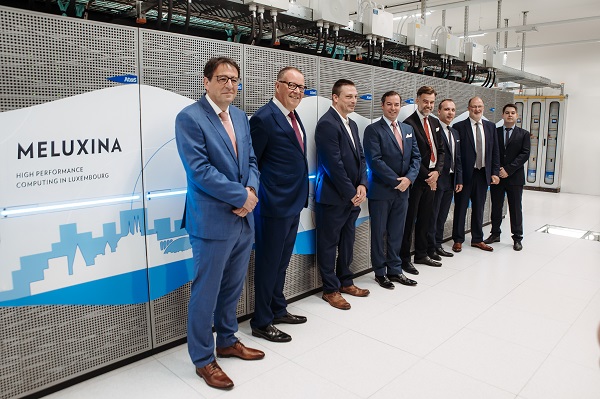 L-R: Mario Grotz, Economy Ministry; Ferdinand Kayser, SES; Guy Schumann, RSS-Hydro CEO; Prince Guillaume; Economy Minister Franz Fayot; Paul Konsbrück, LuxConnect CEO; Roger Lampach, LuxProvide CEO; Valentin Plugaru, LuxProvide CTO;
Credit: Maison du Grand-Duc / Kary Barthelmey
L-R: Mario Grotz, Economy Ministry; Ferdinand Kayser, SES; Guy Schumann, RSS-Hydro CEO; Prince Guillaume; Economy Minister Franz Fayot; Paul Konsbrück, LuxConnect CEO; Roger Lampach, LuxProvide CEO; Valentin Plugaru, LuxProvide CTO;
Credit: Maison du Grand-Duc / Kary Barthelmey
One year ago, Luxembourg commissioned the high-performance supercomputer MeluXina which is hosted in the LuxConnect data centre in Bissen.
On Tuesday 14 June 2022, His Royal Highness the Hereditary Grand Duke of Luxembourg and the Minister of the Economy, Franz Fayot, accompanied by the mayor of the municipality of Bissen, David Viaggi, visited the supercomputer installations on the occasion of the first anniversary of MeluXina. The visit was led by Valentin Plugaru, Chief Technology Officer (CTO) of LuxProvide SA, which is in charge of the MeluXina platform.
MeluXina is used in the context of research, but also by companies for their innovation projects in fields of application as varied as meteorological simulation, climate analysis, automotive and aeronautical design, production of energy, medicine or even financial analysis.
LuxProvide SA and its 23 employees are in charge of operating MeluXina. In order to facilitate access to high-performance computing (HPC) as well as to guide and support companies, Luxinnovation, the University of Luxembourg and LuxProvide jointly manage the national competence centre for high-performance computing. The centre functions as a one-stop-shop for companies by offering personalised support and technical expertise to set up HPC projects, especially for companies with limited skills in this area.
In his address, Economy Minister Franz Fayot said: "The race for high-performance computing is at the centre of international competition in all areas of research and innovation. The issues related to supercomputers are strategic for a country like Luxembourg. Thanks to MeluXina and the national competence centre for high-performance computing, companies and research organisations can now access a wide range of services to set up HPC projects with high added value".
Roger Lampach, CEO of LuxProvide, elaborated: "We are a small, but strategic structure for many companies, since we provide the computing power of MeluXina as a service for industries, SMEs and startups. So far, more than 200 companies from fifteen different economic sectors have already expressed their interest in using MeluXina. With more than 60 projects already carried out on our supercomputer, we are only at the beginning. I appeal to all companies to contact us to analyse together how we can help them boost their activities thanks to the supercomputer". The contact person for businesses at LuxProvide is Matthieu Lefebvre, Head of Supercomputing & Data Solutions (tel.: 85 99 14).
During the visit, the focus was on the concrete use of the MeluXina supercomputer by two Luxembourg test companies: the satellite operator SES and RSS-Hydro, a startup specialising in the exploitation of data resulting from Earth observation to predict floods.
SES's second-generation, high-performance satellite systems are software-driven and highly automated and aim to provide connectivity services to millions of users. This means that the spectrum and transmission power of these satellites must be continuously allocated in the most flexible and optimal way to maximise the performance of the system.
With MeluXina, SES was able to model and test various multi-orbit scenarios in real time, such as spectrum and power allocation, and define the optimal ways to use its communication services for the benefit of its customers. These are expected to be able to serve millions of users around the world in telecommunications, Internet services, business and energy, connectivity on board ships and aircraft and governments.
"Access to MeluXina's capabilities enables real progress in innovation efforts in the field of satellites. Already before the launch of our second-generation O3b mPOWER communication system, we were able to generate various optimisation scenarios in order to design the best possible service for our customers", explained Ferdinand Kayser, Strategic Advisor to the CEO of SES, during his presentation. "Our new systems are based on software that uses complex algorithms and SES performs hundreds of tests that require high computing performance. With MeluXina, we can do this more efficiently and overcome the limitations of conventional computing capabilities".
For its part, RSS-Hydro specialises in the research and development of remote sensing technologies, including drones and satellites, and computer simulations of water-related hazards. The company uses traditional methods and advanced machine learning models to extract actionable insights from geospatial datasets and to simulate water-related risks and their impact.
Guy Schumann, CEO of RSS-Hydro, commented: "We offer scientific building-scale flood risk maps, using the latest scientific advances combined with the latest advances in technological innovation in computer modeling and remote sensing. With MeluXina, we multiply by ten the speed and performance of our flood simulation calculations, which considerably increases the effectiveness and efficiency of our activities".
With a maximum peak computing power of 18 petaflops (corresponding to eighteen million billion computing operations per second), MeluXina ranks among the top 50 high-performance computers in the world. In addition, MeluXina is powered by 100% green energy and is in terms of energy efficiency among the top 15 systems in the top 500 most powerful supercomputers.








